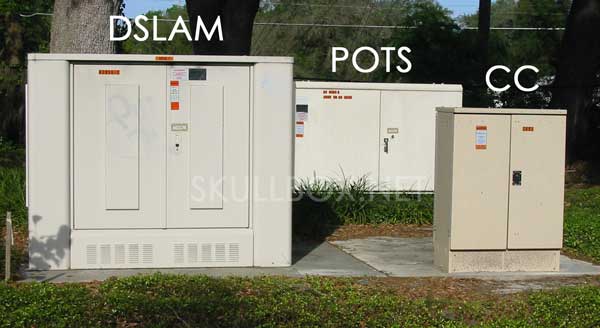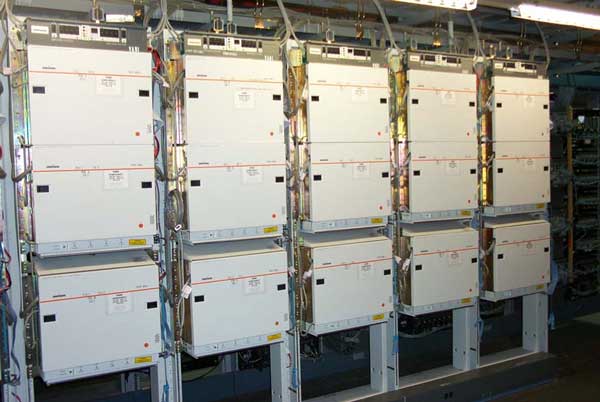
|

|

|

|

|

|

|

|

|

|

|

|

|

|

|

|

|

|

|

|

|

|

|

|

|

|

|

|

|

|
 |
|
|
|
|
Mailing List
|
|
By Joining the mailing list you will be notified of site updates.
|
|
Show Your Support For
This Site By Donating:
|
|
|
|
|


|
|
|
|
Audience: Newbies - System Admins
Last Updated: 3/21/2011 03:11:51 AM
Original Creation Date: 5/17/04 8:13 PM
**All times are EST**
|
|

DSL Cabinet Equipment
By Erik Rodriguez
This article describes and explains the excellent conversation I had with a phone company tech. I caught him working on a terminal box and asked him a ton
of questions.
I had been trying to hunt down a Telco employee for weeks, and on Monday, March 29, 2004, I finally found one. The guy was very polite and helpful. He
took the time to open all the cabinets and explain to me what everything did. However, he said I was not allowed to take any pictures of it :-(
Based on the research I did for central offices, I had a ton of new questions. My first question involved what exactly was in each
cabinet. Since there are 3 different cabinets, I wanted to know what type of equipment each one housed.
Below are images of the (3) cabinets or "boxes" I wanted to know more about.

My Observations:
The DSLAM and fiber optic equipment. The cabinet opens from all 4 sides. Each side contained a different type of equipment:
- Power
- Splice
- Fiber Input
- DSLAM
DSLAM: The DSLAM was comprised of (2) Alacatel boxes. Each box contained cards used to configure access for DSL subscribers. Remember that DSL
uses DWDM multiplexing. Each alacatel box had a serial port interface to manage the device. Below is an image
of the same alcatel devices used in the DSLAM:

Power: The power side was comprised of multiple 4 AWG wires for power and ground. Batteries and rectifiers were also present.
Splice: The splice side looked much like a patch panel. All 24 AWG twisted pairs.
Fiber Input: The fiber input was comprised of a few different model Lucent boxes. There were (2) single mode fiber optic inputs with multiple DS3
cards.
The POTS (Plain Old Telephone System) equipment, contained tons of wires spliced and run to small cards. Each card contained (2) physical
phone lines. It also contained a number of DC batteries and was equipped with rectifiers to charge them.
The cross connect box, labeled CC, provides a way to re-route a phone line in the event of a physical line break.
My Questions:
Q: What topologies are used?
A: A self-healing ring much like a SONET ring is used to provide a reliable telecommunication service.
Q: Does a higher DSL (ex. HDSL, SDSL) require hardware upgrades inside the cabinet?
A: No, that type of thing is a setting made in the computer system at the central office.
Q: What types of security are there for these cabinets?
A: There are 27 different types of alarms, all for different things such as a fire, physical breach, low battery, complete power loss,
fiber break, card outage, etc. The DSLAM is equipped with a special fire surpression system that uses a compound chemical gas to extinguish any flames.
Q: How long do the backup batteries last?
A: Anywhere from 4 hours to 4 days.
Q: What common problems occur with the DSLAM?
A: Cards go out often. It varies from a single card to as many as 5 cards. Sometimes bad cards are shipped from the manufacturer.
Q: Does the weather affect the equipment in any way?
A:Usually none; equipment can be affected by excess heat if the cabinet is sitting in direct sunlight during the summer. In such a case,
a technician will come out and install more fans in the cabinet.
Q:Does your company offer dark fiber?
A:No, we value the integrity of our network, and do not lease our fiber to 3rd parties.
Q:Can T1 lines come in on fiber optics, or do they strictly use copper wire?
A:Newer homes and buildings are wired with fiber. Generally a T1 connection is set up in the POTS box.
Q:Where are all the repeaters for T1 connections?
A:T1 repeaters are located underground every 1600 feet, and must be accessed via a manhole.
Q:What qualifications do you need to work on DSLAMs and telco cabinets?
A:New employees are required to pass several tests on electricity and will start working as a splicer or cable repair technician.
As time passes and you gain experience, you can work your way up to being an RT (Remote Terminal) technician.
Q:How complicated is the setup in DSLAM cabinets?
A:We call it "gee-wiz" technology, nobody knows everything about it. Most of the technicians don't know how it works, they just know how to fix it.
Q:What is the future like for DSL?
A:in the near future, he will probably be able to sit in his van and do everything via wi-fi. Physical console access will only be necessary
to deal with cards. It may even be possible to manage remote terminals from the central office or a home office.
DSL will be an obsolete technology because of all the wireless access currently being deployed.
Contact Us
NOTE: this form DOES NOT e-mail this article, it sends feedback to the author.
|
|
|
|
|
|
